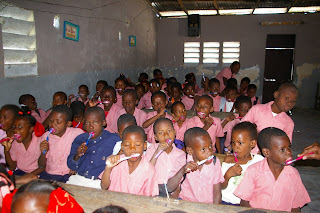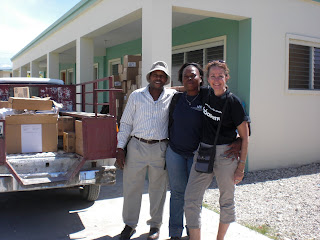
Kyle's Reflections
Tabasamu is a non-profit that provides free dental care and education in and around Kitale, Kenya. The Executive Director, Trey Wilson, made his first to Kenya in May 2004. There has been an annual trip since then and, seemingly, an exclusive focus on the needs of this African country. As time has passed and the interest and passion for such work has grown, members of the Tabasamu Board and friends of Tabasamu have been part of smaller initiatives in other locations. The first such pilot occurred in Summer 2008 and involved young people from my home parish who participated in a mission trip to Guatemala. They used the dental puppet show, wonderfully created by Evelyn Pantuso, and basic dental materials to share the importance of good oral health with children in various schools and churches. Given my presence in Haiti and previous involvement in Tabasamu, it seemed ideal to replicate the same pilot here. My own family’s dental hygienist, Tonia Richard, enthusiastically committed to join me for five days and lead the initiative. She booked her flight and the plans began!

Before my arrival in Haiti, I became aware of the Lamp for Haiti Foundation. They provide free health care for the residents of the Bwa Nef section of Cite Soleil, the largest slum in the Western Hemisphere. They already have a mobile dental clinic and are eager to establish a dental clinic. They were excited by the prospect of a dental education program. Consequently, we scheduled a combination of school visits and community presentations during three of the four days that Tonia was in country.
The Lamp Clinic is run by Joey Prosper and Myrlene Marie (Mimi) Dominique. Joey is a doctor and Mimi serves as the Clinic Manager. They were both born in Haiti and relocated to the states at a young age. They returned to Haiti recently to help address the incredible need for quality health care. Joey and Mimi are people of remarkable character, spirit and dedication. They are passionate about the work and, most especially, the community. I feel privileged to know them and work with them.

There was a rhythm to each presentation. We began with the puppet show, followed with specific instruction on brushing teeth and then, my favorite, disclosing everyone’s teeth to show where they needed to brush more thoroughly. Friday was first program day and included three school visits. The children were all attentive, as were any adults who were present. In each location, community members peeked through the doors, hovered by windows and even looked on from nearby buildings. It was great to see the interest.
Saturday began with a community program in the Lamp Clinic’s seminar room. People began to assemble as soon as we were on the scene. Soon, the room was overflowing with people of all ages, ready to learn about their teeth. There were great questions posed and answered. They were followed by the distribution of hygiene kit soap, washcloth, a package of Kleenex, toothbrush and toothpaste (The group was too large for disclosing). There were not enough hygiene kits for everyone, which prompted some discord. Three Haitian men from the community maintained order by asking everyone to exit the seminar room and re-enter in groups of ten. They also stipulated the children as the recipients. It was really quite remarkable to see such initiative rise from the community. One of the things that I have observed and experienced first hand is the way in which individuals within Haitian communities assume a role of advocate and, if necessary, protector to others. They may care for those within the local family or those who are visiting. It is really quite something to experience.

Following the health presentation, we moved on to a small community of Croix de Bouquets called La Hatt, where we provided a dental program to about 20 youth and a handful of adult observers. This was at the request of Mimi and “Jr.”, a young man who volunteers some time at the Lamp clinic. They were among the most attentive of the audiences. It was great fun to perform the puppet show from the porch of Jr’s grandmother’s home. His grandmother observed from her rocking chair!

Tonia and I had a brief respite on Saturday night with Carla and company at N A Sonje followed by a day in historic Jacmel. Monday morning, we headed to St. Vincent School for the Handicapped. We facilitated four presentations, starting with the oldest students. Many of the participants had been involved with the Diaspora of Hope Artist on Call art camp in November. It was so great to see them again. Two of the four groups included children who were blind, missing limps or sustaining some debilitating physical condition. The remaining two groups of children were deaf. The mirroring of Tonia’s presentation in sign language and the children’s response was an art form in it self. The visit to St. Vincent was the perfect cap to the program.

My primary call as a Missioner is to hear the needs identified by Haitians and work with them to develop sustainable, capacity building systems and structures that can continue following my departure. Tabasamu’s dental education program provides the perfect platform for such a model. In a few short days, Mimi, Patrick, our translator, Moliere, our driver and Jean Robert, Administrative liaison at St. Vincent’s were all drawn into the program. They learned a lot personally, quickly adapted to the needs of the presentation and are enthusiastically awaiting another opportunity to “go on the road”. It was a great few days for us and for a few communities in Haiti.
Tonia's Reflections
I am so fortunate to have been able to travel to Haiti and spend some time with Kyle during her year-long mission stay. Five days was not long enough. Kyle is involved in so many projects and is such an inspiration and motivation to so many people. She is tireless (quite literally!) and is certainly fulfilling the definition of her missioner job description, (to hear the needs identified by Haitians and work with them to develop sustainable, capacity building systems and structures that can continue following my departure).
We had a very productive time presenting dental education to the children. The children received us well and seem inherently happy everywhere we went. I was surprisingly moved with the adults who helped and those who heard the presentation. They were very interested and expressed how much they had learned. We cannot assume people have knowledge - even how to brush their teeth! It is wonderful to share information. Knowledge is powerful.
For those who have served in any capacity before, you know that the "take away" is so much greater than the giving. Please note Kyle's last picture that is posted on March 11th. As I was distributing toothbrushes to the children at St.Vincent's, I found myself handing one to a child without arms and she reached up with her foot, held the toothbrush between two toes and began brushing. I will never forget that moment for the rest of my life. I bring that home with me, and to my job, and to my family and it makes you a better person. That beautiful child without arms puts life in perspective.
Haitians are wonderfully spirited people. They are very hopeful for the future of their nation, yet discouraged by the way they are portrayed by the media. I felt very safe on every part of my travels - even on the public bus with a live chicken under the seat and a stranger practically sitting on my lap! It is a beautiful country that indeed needs help but they are not sitting back letting us do all the work. The Haitians have their sleeves rolled up and are ready to dig in.
One project seems to inspire another. There is so much to be done - one step at a time. I was able to experience the coming together of so many people and talents. A group of woman from Bucks County sent 50 hand-knit "duduza" dolls for us to distribute. Another friend, Gary Rabinowitz, sent two guitars for the children to learn on. Kyle has arranged for free lessons for 15 children at St. Vincent's School for the Handicapped. Tabasamu granted us money for translation and toothbrushes. The dentist I work for, Paul Leventhal, sent me with supplies and helped with the trip preparation. And that was all before I left the ground!
I don't know how to close this blog because I don't want it to end! I hope all this good stuff keeps going and going! Thank you so much Kyle!!!!













